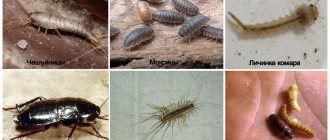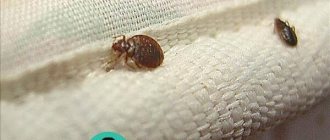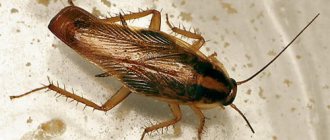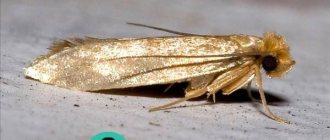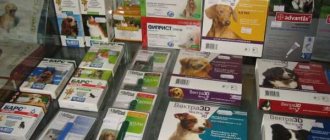Fleas cause severe discomfort to your dog and can cause harm to his body. To destroy them, special preparations are used that must be used correctly. Otherwise, you may harm the animal. There are a large number of flea treatments for dogs available in various forms.
There are many flea treatments for dogs.
Why do dogs get fleas?
Fleas appear in a dog living at home if the pet has had contact with an infected animal or walked in a place where there are parasites . Insects, waiting for prey, sit on plant stems, leaves of bushes, park paths, grass and instantly move to the animal’s fur. The height jump of adults is 3 m, the length jump is 2 m.
A dog will definitely become infected with fleas if it has not been treated with special preparations. Otherwise, the animal is protected from infection not only by these insects, but also by scabies and ixodid mites.
Symptoms of infection
The main symptoms indicating that a pet is infected with fleas are:
- itching, which causes the dog to constantly scratch;
- hair loss;
- the appearance of small ulcers on the skin in the place where the animal scratches;
- dark balls of feces;
- white clusters of larvae;
- the fleas themselves, which quickly hide in the undercoat.
In addition, the pet may become very anxious, become irritable, lose appetite, begin to sleep poorly, bite sharply into the skin and click its teeth. The dog's eyes often water, and in severe cases, extensive bald patches appear in the croup area, on the withers and at the base of the tail.
Special means for removing insects and rules of use
There are a large number of products that can help rid your dog of fleas. They are intended for large and small breeds, for adult pets and puppies.
Flea drops
The most effective and easy-to-use flea remedies are drops. To achieve a positive result, the drug is applied once to the dog’s withers area. For preventive purposes, the animal is treated once every 2 months. However, the drops have the disadvantage of an excessively high concentration of a toxic substance.
As a result of using the product, the pet develops various negative consequences, so some drops are prohibited for puppies 1-2 months old. But most medications are well tolerated by dogs.
Hartz flea drops for dogs.
Rating of the best products:
- Hartz. The drops contain phenothrin, which kills flea eggs, adults and their larvae. This is the safest drug that is used for puppies of all ages, as well as small breed animals. They are practically not washed off with water, and extremely rarely lead to the development of side effects and allergic reactions.
- Stronghold. This is a complex remedy intended for the treatment of dogs. With its help, adults and larvae are hatched. After the first application, reliable protection of the animal is provided, which lasts 2 months. The drug is approved for lactating bitches and puppies over 1.5 months of age. To get the maximum effect, it is recommended to further treat the dog after 4 weeks.
- Leopard. These are inexpensive drops, but have a large number of side effects. Often, when taking them, excessive salivation, allergies, etc. occur.
Insect killing sprays
Aerosols and sprays are the most effective means to help fight fleas . They are easy to use, and to get results, the drug is applied to the entire body. It is recommended to treat the animal in a well-ventilated room. The death of adult parasites occurs almost immediately after application of the product. The effect of the medicine lasts for several weeks. Frontline and Bars are considered the most effective means.
List of the best drugs:
- Frontline. This is a high-quality and affordable product, the main component of which blocks the functioning of the nervous system of parasites, resulting in paralysis and death. The spray effectively protects against fleas for 3-5 weeks. The drug is approved for the treatment of even small pets that are 2 days old. After treatment, dogs should not be bathed for 2 days.
- Leopard. The spray is applied to the animal's fur, and the main components begin to accumulate in the sebaceous glands, hair follicles, and upper layer of the epidermis, forming a protective barrier against parasites within a month. The drug does not penetrate into the bloodstream. It is contraindicated for pets under 10 weeks of age, pregnant and lactating bitches, weakened and sick dogs.
- Beaphar. This is an insecticidal product that is extremely safe. Despite its slight toxicity, the spray is good at getting rid of blood-sucking parasites. Approved for the treatment of puppies that have reached 2 months of age and small breed dogs.
Using shampoos
Flea shampoos are most often used simultaneously with other antiparasitic agents. Before treatment, the animal is combed and washed. The drug is applied to the entire surface of the body, rubbed until foam appears, after 5 minutes, rinse and dry the hair. When using the product, do not allow it to get into the dog’s ears and eyes. The advantages of shampoos include complete safety, low cost and no side effects.
Shampoo for dogs Phytoelite.
The most popular products:
- Phytoelite. This is a medicinal insecticidal drug that is used externally. It contains the synthetic pyrethroid permethrin, which has a pronounced enteric-contact effect against flea larvae and adults. Thanks to the main component, the neuromuscular transmission of impulses from peripheral nerves is blocked, resulting in impaired coordination of movement, paralysis and death of parasites. It is forbidden to treat puppies under 2 months of age, lactating bitches, sick and weakened animals with the drug.
- Doctor ZOO. The shampoo is made based on natural essential oils. The product has a repellent and insecticidal effect, removes fleas and prevents their appearance in the future. The disadvantages include a short period of validity and not a very convenient method of application.
- Beaphar. The main component has a nerve-paralytic effect, causing rapid paralysis or shock, and subsequently the death of fleas. The particles of the product that remain in the dog’s fur after washing are active for 2 weeks. The drug is prohibited for severe skin lesions, as well as for the treatment of puppies under 6 months and pregnant bitches.
Special collars
Anti-flea collars for dogs are made of plastic. They are presented in the form of a narrow flexible tape with a fastening buckle.
This product has a specific smell because it is saturated with toxic chemicals that repel insects.
The collar works as follows: it is put on the dog, and it heats up under the influence of the animal’s body temperature. After this, the poison begins to be distributed over the pet’s skin and fur, while it penetrates the epidermis and accumulates in the sebaceous glands.
The dog will be completely protected from fleas in 2 days. The required amount of the toxic substance is retained throughout the entire time the collar is worn - about 4 months. The product should not be removed even at night. However, this remedy can lead to the appearance of such negative reactions of the body as lacrimation and drooling, swelling, allergic dermatitis, and severe agitation.
The most popular types of collars:
- Chemical. The tape is impregnated with deltamethrin, a strong insecticidal substance that has an immediate effect on fleas. They are used only for adult animals.
- Biological. Such collars are based on the healing properties of essential oils and medicinal herbs. To enhance the effect, they are used with tablets, aerosols, and drops. They are allowed to be worn by weakened and sick pets, pregnant bitches and puppies.
- Ultrasonic. These products do not have a strong odor and do not contain harmful chemicals, but they are ineffective.
The most common brands: Kiltix, Scalibor, Beaphar Ungezieferband, Foresto.
Flea tablets
Bravecto flea tablets for dogs.
Flea tablets have the following benefits:
- allowed for elderly dogs, pregnant and lactating bitches, puppies from 2 months;
- do not cause side effects;
- have a pleasant smell and taste;
- can be used to treat animals that develop allergic reactions to medications.
The most effective drugs:
- Bravecto. They are produced in chewable form. When it enters the body, the active substance is absorbed into the blood and forms a chemical bond with proteins contained in the blood plasma. When the drug enters the blood of a flea, it has a paralyzing effect on it, as a result of which it dies. All parasites die within 8-11 hours. The effect lasts 3 months.
- Frontline Nexgard. The drug begins to act half an hour after administration. It is effective against 2 types of fleas. The drug is approved from 2 months.
- Comfortis. When using the product, the main component penetrates into the blood. When a flea bites a dog, the poison enters the parasite's body, negatively affecting the nervous system and destroying the intestines. The effect occurs 2-3 hours after taking the tablet. Contraindicated for puppies under 1 month of age.
Combs and brushes
The classic way to rid your pet of fleas is combing. Combs are used as an additional remedy to the main anti-flea drugs. With the help of brushes and combs, the owner rids the pet of parasites by combing them against or along the fur. This method is considered not very effective, but accessible. They resort to it if the dog is not too heavily infected.
The following brushes and combs are available for combing:
- Zoonic;
- Hello Pet;
- TRIOL.
Advantages and disadvantages of drops against fleas and ticks (sometimes against worms) for cats
The advantages of the drop form of drugs against exoparasites are:
- Ease of use.
- Reliable and long-lasting protection for your pet, which is especially important when the cat is free-range and has the possibility of contact with other animals.
- Quick and effective removal of parasites.
- If you follow the dosage and instructions for use, these drops are completely safe for your cat.
- Protection against re-infection due to the fact that many of the insecticides included in the drops also act as repellents.
There are few disadvantages to flea drops, but they still exist:
- There is a possibility that your cat will be allergic to one of the components of the drops, most often to a specific insecticide.
- Some drops cannot be used to treat sick and weakened animals, as well as pregnant, lactating cats and small kittens.
Allergy to toxins
Some cats are sensitive to the insecticides found in external parasite drips and may develop an allergy to them.
Allergies to drops can manifest themselves in different ways. Most often, its signs are:
- Itching and redness of the skin. This is especially evident in the place where the drops were directly applied: ulcers or weeping eczema can even form there.
- Rashes are noticeable on the skin, urticaria may appear, and later dermatitis.
- Hair loss.
- Abundant mucous discharge from the nose and lacrimation: “wet tracks” are noticeable on the animal’s face.
- Coughing and sneezing.
- In severe cases, difficulty breathing may occur.
Important!
The most severe manifestation of allergies is anaphylactic shock, which can lead to fatal consequences. If, after applying the drops, the cat has the first, even the most minor, manifestations of an allergy, it is necessary to wash the drug off the skin as quickly as possible as thoroughly as possible. Then you need to take your pet to the veterinarian.
How can they be dangerous?
In addition to allergies, drops from fleas and ticks can also be dangerous and pose a risk of poisoning for the animal. Most often this happens for the following reasons:
- Failure to comply with the instructions when using the drug. For example, the owner, without reading the instructions, squeezed the entire drug from a pipette onto the pet’s skin, when only 1-2 drops should have been applied.
- Bathing the cat in the first few days after treatment: this is most often the cause of poisoning.
- The drops turned out to be fake or expired.
- The drops were applied not to the withers, but to another part of the body. In this case, the cat can easily lick them off when he tidies up his fur.
- Incorrect dosage without taking into account the pet's weight.
- Treatment of suckling kittens. In this case, a nursing cat licks its babies and thus ingests the drug from their fur.
At the same time, the first signs of poisoning with flea drugs develop very quickly, in just 10-15 minutes, and the strength of their manifestation depends on the amount of toxin that has entered the animal’s body.
Symptoms of possible poisoning are:
- Increased salivation.
- Impaired coordination of movements: the cat drifts to the side when walking, it begins to crash into furniture and cannot normally pass through doorways.
- Nausea.
- Vomiting and diarrhea.
- Redness of the mucous membranes and skin on and inside the ears.
- Itching and rashes on the skin.
- Convulsions similar to epileptic ones.
- Loss of consciousness.
- If the poisoning is very severe, the animal may fall into a coma.
Why might a cat be lethargic after treatment?
The lethargic state of a cat after treatment with flea and tick drops may indicate severe intoxication of the animal, which often happens when the dose of the drug is exceeded.
To prevent this from happening, it is necessary to take the cat to a veterinary clinic at the first appearance of symptoms of intoxication, including suspicious lethargy.
If this is not possible for some reason, then you can water the animal with rice water and give it adsorbents, for example, activated carbon, previously diluted in water.
Folk methods of struggle
If it is not possible to treat your dog with flea medications, you can resort to folk remedies. They are not highly effective, so they are used to prevent infection of the animal. For example, 2-3 drops of any essential oil are applied to the fingers and rubbed into the coat. The strong smell repels fleas. Essential oils of coniferous trees and eucalyptus are most effective.
If the pet lives not in the house, but in a booth, the area around it is treated. To do this, leaves and stems of wormwood, sawdust, and branches of coniferous trees are laid out on the floor and next to the house. To get rid of parasites, you can wash your dog not with shampoo, but with soap based on dust or tar. This method is completely safe, but it has the only drawback - the animal must be treated several times to completely destroy fleas.
For mild damage, use vinegar. It is diluted with warm water in a ratio of 1:3, the wool is washed and left for 15 minutes. Avoid contact of the solution with the eyes and mucous membranes.
Action of drops
Drops with an insecticidal effect are used to combat external ectoparasites - mites, ticks, lice eaters; these products are often used for preventive purposes. The medicines have an oily structure, are packaged in small plastic pipettes, the dosage of active substances is determined depending on the weight of the animal, and products are separately produced for puppies aged 2–6 months.
Modern anti-flea drugs include the latest generation of insecticides - phenothrin, permethrin, fipronil, methoprene, moxidectin. These substances penetrate the blood, block the transmission of impulses, disrupt the functioning of the nervous system, and cause paralysis in parasites, which leads to their rapid death. Additionally, the drops repel bloodsuckers from the dog and destroy eggs and larvae of insects in the pet’s fur.
Fleas do not live permanently in animal fur; they jump on a dog only to feed, after which they settle close to the food source.
Therefore, in order to get rid of parasites, you need to treat not only the pet, but also its bedding, furniture, and carry out a thorough cleaning of the house.
How to apply to skin
Most often, the instructions for dogs indicate that the drops should be applied to the withers; if the dog is large, the manufacturers recommend dripping the medicine pointwise along the entire spine. The skin and fur must be completely dry.
After applying anti-flea drops, they need to be carefully rubbed into the skin; it is better to treat your pet with gloves, and after finishing the procedure, wash your hands well with soap.
Within a few hours after applying the drops, you can go for a walk, but you must walk away from other animals, plantings, and other possible habitats of parasites, since the protective effect of the drugs begins after 12–48 hours. It is better to refrain from water procedures for two days before treatment and after applying the drops.
The protective properties of the drops remain for 3–6 weeks after application; the duration of action depends on the composition of the veterinary drug. If your pet is often bathed with shampoo, then the dog must be treated once every 14 days.
Preventive actions
It is difficult to prevent fleas from appearing on your pet, but you can reduce the risk of parasite infection several times.
Option for flea treatment for dogs.
To achieve this, the following preventive measures are carried out:
- put on a flea collar before going for a walk;
- Regularly treat the dog's bedding with disinfectants;
- monitor the cleanliness of the animal’s fur and comb it;
- do not allow contact with unfamiliar dogs;
- do not walk the dog in places where there are a lot of fleas (abandoned areas, basements);
- examine the pet after each walk;
- fill the animal's bedding with sawdust, which fleas do not like;
- wash paws and shoes after a walk.
Room treatment products
To treat a room for fleas, various means are used. Insecticidal preparations in the form of an aerosol are characterized by good penetrating ability. There is no need to pre-dilute them in water, and they allow you to treat a fairly large area. Effective means: Raptor, Dichlorvos, Raid, Combat. With their help, you can rid the room of fleas and their larvae in 1-2 hours.
Concentrates for preparing the solution are used for professional treatment of the premises. A large amount of solution is obtained from one bottle. Such products do not leave stains on fabrics or furniture surfaces and are odorless. These include Biorin, Get, Chlorpyrimac.
You can treat the room with insecticidal preparations in powder form. Scatter them in places that are inaccessible to children and animals. Such products include Fas-Double, Clean House, Phenaxin, Brownie. Thanks to them, you can get rid of fleas in one application.
Conclusion
Flea and tick drops are a truly effective and reliable remedy for ridding your furry pet of external parasites. Many of these drops also prevent re-infection of the cat with fleas and other bloodsuckers, and some companies even produce drops on the withers, which rid the animal of any parasites: both external and internal. Many cat owners have long appreciated the drop form of parasite protection products and remain faithful to the drops they have chosen for many years.
The danger of dog fleas to humans
Dog fleas can bite a person when they are very hungry. Most often this happens at night.
Parasite bites can pose the following dangers to humans:
- Causes an allergic reaction. Often an allergy develops to the parasite's saliva. This causes swelling, itching, redness, and papules. In some cases, bites provoke psoriasis or eczema.
- They introduce an infection. A bite can transmit dangerous infectious diseases such as helminthiasis, tularemia, brucellosis, typhus, and salmonellosis.
Reviews from pet owners
Elena, 35 years old. Moscow: “When my dog got fleas, the veterinary pharmacy recommended Bars drops. I applied the product once to dry skin in the neck area at the base of the skull and between the shoulder blades so that the animal could not lick it off. For 3 days after this, the pet was not washed. As a result, all the parasites died, and the dog no longer suffered from itching.”
Mikhail, 43 years old, Saratov: “It’s convenient to use a spray to kill fleas on dogs. This drug, unlike drops and tablets, acts quickly, and there is no need to treat the animal again. I find Frontline effective. It quickly helped rid my pet of such parasites. But you need to use it correctly so that the spray does not get into the dog’s respiratory system.”
Source
Actions and side effects
After application, the medicine enters the fatty layer of the animal, penetrates the skin, sebaceous glands and hair follicles. During the bite, the parasite receives a dose of medication, which causes disruption of its motor activity (nerve impulses are blocked) and death. The drug does not enter the animal’s blood, which eliminates the possibility of intoxication (subject to the dosage).
Drops may differ in composition.
The following insecticides may be present as active ingredients:
- pyrethroids;
- phenylpyrazoles;
- neonicotinoid compounds;
- phosphorus-containing substances.
Pyriproxyfen and methoprene are juvenile insecticides and are ineffective against adult insects. Their action is aimed at interrupting the development process of the insect at the stage of eggs and larvae. Preparations based on these substances are used as additional ones.
It is necessary to ensure that the animal does not lick the medicine immediately after application. Otherwise, poisoning with a toxic substance is possible. A visit to the veterinarian and gastric lavage will be required.
If the dosage is not observed, side effects may develop:
- restless behavior;
- severe trembling;
- bowel dysfunction;
- vomit;
- lacrimation;
- increased salivation;
- rapid breathing.
In case of overdose, it is recommended to bathe the dog by rinsing the skin and fur. Undesirable symptoms will disappear within 1-2 days.
Any product can cause an allergic reaction in an animal.


